
Shrewsbury Barrow is a Bronze Age burial mound (also known as a tumulus) in Shooter's Hill in South East London, in the Royal Borough of Greenwich. It is a Scheduled Monument. [1]

Shrewsbury Barrow is a Bronze Age burial mound (also known as a tumulus) in Shooter's Hill in South East London, in the Royal Borough of Greenwich. It is a Scheduled Monument. [1]
The Shrewsbury Barrow is named after the 15th Earl of Shrewsbury, who built nearby Shrewsbury House in 1789 (that Shrewsbury House was demolished, and, in 1923, replaced by the existing building of the same name). [2] The barrow is adjacent to Shrewsbury Park. [3]
It is the only surviving barrow of a group of six; or possibly two groups of three. [4] The other barrows were destroyed during the development of the surrounding estate in the 1930s. [5] The barrows are located at the top of the hill, and would have been visible from the foot of the hill, silhouetted against the sky. [6]
The only detailed description of the lost burial mounds is that of Col AH Bagnold in the parish magazine of Christ Church, Shooter's Hill. [7] The Shrewsbury Barrow is No 1 in Bagnold's list. Tower House has been demolished, but, in his childhood, the future cabinet minister Douglas Jay lived there, and he recalled playing on the tumulus as a child. [8] Bagnold's optimism about the future prospects of No 6 was misplaced.
"No. 1 Mound, about 75ft in diameter, formerly in Tower House garden, now in the angle between Plum Lane and Mayplace Lane. Opened recently; contents unknown.
No. 2 Mound, about 36ft in diameter on a site formerly in the grounds of Shrewsbury House, now on the west side of Ashridge Crescent. Destroyed 1934-35.
No. 3 Mound, about 60ft in diameter on a site on the north side of Ashridge Crescent. Destroyed 1934-35.
No. 4. A similar mound on the same side of Ashridge Crescent. Destroyed 1934-35.
No. 5. A very low mound was on a line between two conspicuous trees – a cedar and a Spanish chestnut – which have been allowed to remain in Ashridge Crescent. Destroyed 1934-35.
No. 6. Shrewsbury Park L.C.C. Recreation Ground. Under the trees a few yards west of the drinking fountain is a symmetrical mound 45ft – 50ft in diameter and about 2ft high. It has not been opened.
No. 7. Plumstead Common. On the eastern part (Winn’s Common) is a mound about 60ft in diameter and much worn down. It has obviously been opened, but when and by whom cannot be ascertained, nor is anything known about the fate of any relics this tumulus may have contained.
It is a most regrettable fact that six mounds which, perhaps, all contained interesting remains of the people who lived long ago in this district have all been destroyed or plundered and their contents hopelessly lost. The single barrow which has not been opened (No. 6) is fortunately safe from unauthorised relic-hunters. Some day perhaps and with the consent of the London County Council a proper examination of this site may be made." [9]
It is located on the corners of Brinklow Crescent and Plum Lane. It is approximately 25m wide and 1.5m high. [10]
There were other burial mounds nearby, and a small number remain, including the one on Winn's Common (No 7 in Bagnold's list) and a badly damaged one in Lesnes Abbey Woods. [11]

A tumulus is a mound of earth and stones raised over a grave or graves. Tumuli are also known as barrows, burial mounds or kurgans, and may be found throughout much of the world. A cairn, which is a mound of stones built for various purposes, may also originally have been a tumulus.

Shooter's Hill is a district in South East London within the Royal Borough of Greenwich. It borders the London Borough of Bexley. It lies north of Eltham and south of Woolwich. With a height of 132 metres (433 ft), it is the highest point in the Borough of Greenwich and one of the highest points in Greater London. Shooter's Hill also gives its name to the A road which passes through east to west and is part of the A207 road, the A2 road, and also Watling Street.
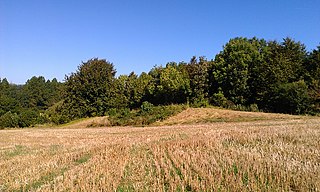
Julliberrie's Grave, also known as The Giant's Grave or The Grave, is an unchambered long barrow located near to the village of Chilham in the south-eastern English county of Kent. Probably constructed in the fourth millennium BCE, during Britain's Early Neolithic period, today it survives only in a state of ruin.

A mound is a heaped pile of earth, gravel, sand, rocks, or debris. Most commonly, mounds are earthen formations such as hills and mountains, particularly if they appear artificial. A mound may be any rounded area of topographically higher elevation on any surface. Artificial mounds have been created for a variety of reasons throughout history, including habitation, ceremonial, burial (tumulus), and commemorative purposes.

Flowerdown Barrows is a Bronze Age Barrow site near Littleton, Winchester, Hampshire, England. It is a scheduled monument looked after by English Heritage.

The Stoney Littleton Long Barrow is a Neolithic chambered tomb with multiple burial chambers, located near the village of Wellow in the English county of Somerset. It is an example of the Cotswold-Severn Group and was scheduled as an ancient monument in 1882. It was one of the initial monuments included when the Ancient Monuments Protection Act 1882 became law.
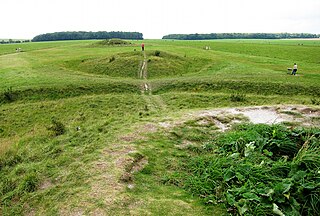
The Cursus Barrows is the name given to a Neolithic and Bronze Age round barrow cemetery lying mostly south of the western end of the Stonehenge Cursus, in Wiltshire, England. The cemetery contains around 18 barrows scattered along an east-to-west ridge, although some of the mounds are no longer visible. The Cursus Barrows can be seen just north of the route between the Stonehenge Visitor Centre and Stonehenge.
Battlegore Burial Chamber is a Bronze Age burial chamber located in Williton, Somerset. It is composed of three round barrows and possibly a long, chambered barrow. The site was excavated in 1931 by George Gray. The name "Battlegore" comes from this site being attributed to the location of a Danish raid in 918 AD or 988 AD. At least as early as the 14th century, the site was referred to as "Bytelgore", a predecessor of the word "Battlegore". Along with three nearby round barrows it has been scheduled as an ancient monument.
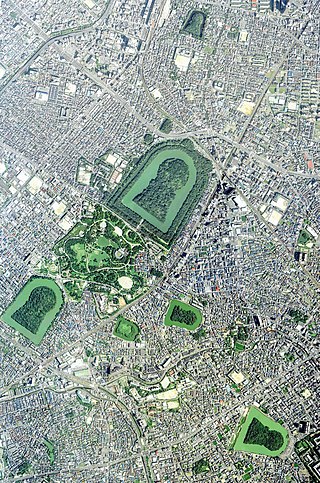
The Mozu Tombs are a group of kofun —megalithic tombs—in Sakai, Osaka Prefecture, Japan. Originally consisting of more than 100 tombs, only less than 50% of the key-hole, round, and rectangular tombs remain.

The Takarazuka Kofun (宝塚古墳) is a group of Kofun period burial mounds located in the Takarazuka neighborhood of the city of Matsusaka, Mie Prefecture in the Kansai region of Japan. It was designated a National Historic Site of Japan in 1932.
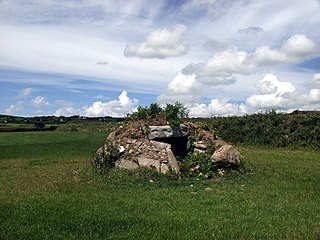
Brane Barrow, or Chapel Euny Barrow, is a Neolithic entrance grave located near the hamlet of Brane, Cornwall, England, UK. It is considered to be one of the smallest and best preserved burial monuments in Britain.
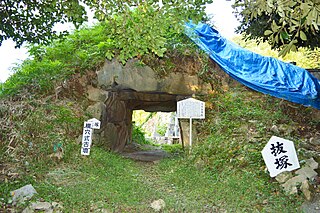
The Takayasu Senzuka Kofun Cluster is a group of Kofun period burial mounds, distributed around the foot of Mount Takayasu at elevations of 50 to 300 meters, in the city of Yao, Osaka Prefecture. in the Kansai region of Japan. The tumulus group was designated a National Historic Site of Japan in 2015.
Beacon Hill, also known as Harting Beacon, is a hillfort on the South Downs, in the county of West Sussex in southern England. The hillfort is located in the parish of Elsted and Treyford, in Chichester District. It is a Scheduled Ancient Monument with a list entry identification number of 1015915. The hilltop enclosure is dated to the Late Bronze Age, from the 8th to 6th centuries BC. The hillfort defences were renewed during the Late Iron Age.

Benty Grange is a Site of Special Scientific Interest in the parish of Monyash in Derbyshire, England. 21.1 ha in size and with at least four species of grass and ten others of plant, it is considered of national importance as one of the largest areas of unimproved species-rich neutral lowland grassland in the Peak District National Park. The area was confirmed as a Site of Special Scientific Interest on 8 March 2013, following notification of the designation on 19 June 2012.

The Nakagō Kofun Cluster is a group of kofun burial mounds located in the Sakashita neighborhood of the city of Tsuruga, Fukui in the Hokuriku region of Japan. The site was designated a National Historic Site of Japan in 1988.

Shrewsbury Park is a public park situated on Shooter's Hill, south of Woolwich, in the Royal Borough of Greenwich in south east London.

Wor Barrow is a Neolithic long barrow on Cranborne Chase, about 1 mile (1.6 km) east of Sixpenny Handley in Dorset, England. It is a scheduled monument.

The Kannonzuka Kofun (観音塚古墳) is a Kofun period burial mound, located in the Asuka neighborhood of the town of Habikino, Osaka in the Kansai region of Japan. The tumulus was designated a National Historic Site of Japan in 1991.

The Tamaoka Kofun cluster (玉丘古墳群) is a group of seven kofun burial mounds located in the Shinya, Tamaoka and Tamano neighborhoods of the city of Kaisai, Hyōgo Prefecture, in the Kansai region of Japan. The Tamaoka Kofun was individually designated a National Historic Site in 1943, with the others added in 1978 and the area under protection expanded in 1997.

The Naruto Itano Kofun cluster is a group of nine kofun burial mounds located between the city of Naruto and Itano, Tokushima Prefecture, on the island of Shikoku, Japan. The tumuli were collectively designated a National Historic Site in 2016.